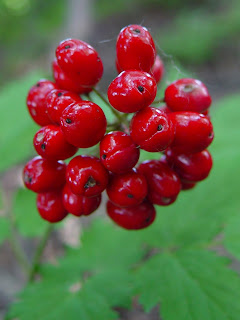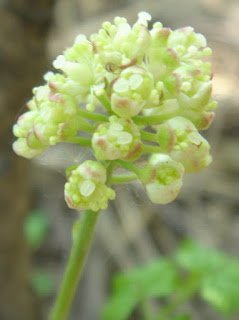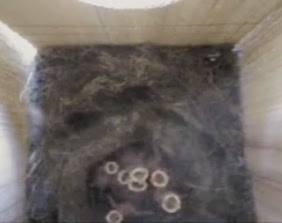Walking through the woods in snow.
Some plants display interesting winter personalities, very different from their growing season garb.
The Eastern Prickly Gooseberry Ribes cynosbati reaches out its long curving canes to call my attention to their defense of juicy berries this coming summer.
1/31/2017
1/18/2017
12/18/2016
red bellies

A pair of Red-bellied Woodpeckers live in the wild wild woods. This winter, they come to the feeder tray one at a time, so observers might think there is only one. But they give themselves away when they call to one another from different trees. The male has more red feathers on his head, extending from his lores all the way to the nape of his neck. And yes, they do have a patch of red or orange feathers on their bellies.
12/10/2016
ground camouflage
Camouflage of brown and gray and buff. The outfit allows a sparrow to blend in among the leaves and litter while hunting for seeds, fruits, and insects on the ground. But the pure white throat, striped head, and yellow lores gives away this White Throated Sparrow. They've come south for the winter from Canada where they breed and raise young in nests on the ground.
12/08/2016
nuthatch
They often start high in a tree and move down head first, probing into bark crevices or chipping away at wood to find food while moving quickly at odd angles. On a vertical surface like a suet cage, they turn upside down, pausing to crane their necks up and back for a look around.
11/29/2016
reflections on a rock
Wandering in the woods, I came upon this rock. It has been there a long while and I've walked by it before. But today it looked more interesting with a pool of rainwater in the depression, reflecting the tree trunks above.
10/24/2016
bird feeder garden
The veggie garden has been transitioned to a feeder garden for birds and pollinators. This year -- among the tomatoes, beans, peas, and squash -- I planted more native flowering plants. We watched as the nesting birds nearby brought their juveniles to the feeders and taught them how to feed themselves rather than gaping and begging. Now, with seed feeders and suet cages loaded, we'll start FeederWatch in a few weeks; we'll enjoy watching the birds that gather here and report our counts for ornithology research.
10/20/2016
chipmunks and sparrows
Stripes in the grass! The chipmunks Tamias striatus often hang out beneath the feeder tray. They can hide among the raspberry canes and safely dart out to gather seeds that the birds fling over the edge. The stripes on the chipmunks' backs give them away when they think they are being stealthy.
(They love tomato juice -- in the summer, they chew holes in my garden tomatoes and suck the juice.)
This week migrating White-throated Sparrows Zonotrichia albicollis joined the chipmunks gathering a meal, kicking among the grass to find each seed. Both species display stripes as part of their camouflage outfit.
(They love tomato juice -- in the summer, they chew holes in my garden tomatoes and suck the juice.)
This week migrating White-throated Sparrows Zonotrichia albicollis joined the chipmunks gathering a meal, kicking among the grass to find each seed. Both species display stripes as part of their camouflage outfit.
| Eastern Chipmunk |
| White-throated Sparrow |
10/18/2016
autumn harvest
| female Northern Cardinal Cardinalis cardinalis on birch |
The winter "guild" of feeder birds is forming. The adult birds in the wild wild woods have molted into their new feathers; their offspring juveniles have learned to fly and hunt on their own. As the leaves change color and insects are less abundant, birds instead harvest the ripe fruits and seeds on shrubs and trees.
10/08/2016
travel ready
The hummingbirds have been filling up on nectar for their migration south in coming days. This is the latest date I've seen Ruby-throated Hummingbirds still in Minnesota. But then, the climate has allowed flowers to bloom later than usual too.
9/10/2016
milkweed munchers
One leaf of Common Milkweed was being devoured by both a caterpillar and a beetle. I wonder if either knew the other was there?
8/20/2016
Indianpipe
 Indianpipe Monotropa uniflora is white because it contains no chlorophyll; it derives water and other nutrients by tapping into the thread-like
cells of the vegetative part of soilborne mycorrhizal fungi.
Indianpipe Monotropa uniflora is white because it contains no chlorophyll; it derives water and other nutrients by tapping into the thread-like
cells of the vegetative part of soilborne mycorrhizal fungi.It appears in forests, scattered, and uncommon. It will grow near a narrow range of mushrooms in the Russulaceae family. We saw this on a field sketching day in a nearby remnant of Big Woods.
Indianpipe is also called Ghost Plant or Corpse Plant.
7/30/2016
sunflowers
7/29/2016
resident Hummingbirds
7/02/2016
feathered nest
Tree Swallows Tachycineta bicolor, who line their nests with found feathers, fledged their five young out of the nestbox a few days ago. This is what I found when clearing out the box. I clean and save such feathers, then put them out again in Springtime for the next nesting season. Some birds place colored or shiny items in their nest . . . wire, yarn, ribbons, etc.
This collection included a little blue sparkly hair pin!
This collection included a little blue sparkly hair pin!
6/28/2016
baneberry
Red Baneberry, also known as Toadroot and
Chinaberry, grows in shady damp areas.
The white flowers grow in spikes that bloom during May in the wild wild
woods. Through the summer months,
Baneberry Actaea rubra ripens its fruits, which are egg-shaped berries, one-half inch long,
shiny, containing several seeds. In late summer, the berries turn bright red
with a black dot on them. The berries
are bitter and very poisonous, except to birds that disperse the seeds.

6/11/2016
Downy woodpeckers and squirrel
When the adult birds are away, a red squirrel comes by to see if he can peek in.
6/04/2016
Downy Woodpeckers feeding young
6/03/2016
Worms? Monsters?
Worms? Monsters? These are “finger galls”.
Insects or mites feeding on a leaf, or laying eggs on or injecting eggs into part
of a plant, cause galls to form. The leaf tissue reacts by increased production of normal plant
hormones and localized plant growth.
The outcome is an abnormal plant structure called a gall. These look like tiny wiggly "fingers" protruding from elm leaves.
Gall formation usually occurs in late spring during the
accelerated growth period of new leaves, shoots, and flowers. This is when insects might be feeding on plant tissue, or emerging in their life cycle to lay eggs. The gall-making insect develops inside the gall and the
gall continues to grow as the organism feeds and matures. In autumn and winter, some birds feast on
the insects they find inside galls, especially on goldenrod.
5/23/2016
peek inside a nest
A pair of Tree Swallows Tachycineta bicolor are nesting in one of several nest boxes near the wild wild woods. Today she laid the third egg. She is not yet incubating them, but keeps guard at the box opening all day.
5/22/2016
feeding baby birds
5/21/2016
furnishing a nestbox: House Wren
A House Wren Troglodytes aedon carries twigs, one at a time, to a nest box.
The male works until he fills the box with twigs, leaving a small cup or cavity.
The female adds soft grasses, fur, feathers, and junk to line the cup where she will lay her eggs.
Below, we peek inside another nest box containing a cozy nest for seven wren eggs.
The female will incubate the eggs for about 2 weeks.
5/20/2016
woods in bloom
top left: Arisaema triphyllum Jack-in-the-Pulpit; top middle: Geranium maculatum Wild Geranium; top right: Asarum canadense Wild Ginger; and a view of Aquilegia Columbine, all blooming now in the wild wild woods.
5/15/2016
nest cavity
A pair of Downy Woodpeckers decided the tree stump near the feeder garden is a good prospect for their 2016 nest cavity. They've been excavating into the old tree for a few weeks. Today, the female peeked out long enough for a look around; it was long enough for us to get a look at her!
5/14/2016
new hatchlings
Seven little Black-capped Chickadee eggs hatched in the last few days. The nestbox cam caught a snapshot when they were all gaping for food.
Subscribe to:
Posts (Atom)



























